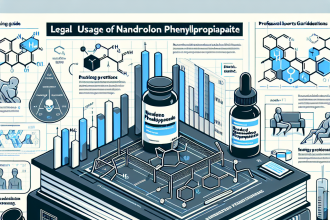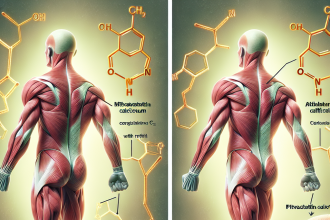-
Table of Contents
Exemestane Use in Preventing Gynecomastia Among Athletes
Gynecomastia, the enlargement of male breast tissue, is a common side effect of anabolic steroid use among athletes. This condition not only affects physical appearance but can also lead to psychological distress and decreased performance. As a result, many athletes turn to the use of aromatase inhibitors, such as exemestane, to prevent gynecomastia. In this article, we will explore the pharmacokinetics and pharmacodynamics of exemestane and its effectiveness in preventing gynecomastia among athletes.
Pharmacokinetics of Exemestane
Exemestane, also known by its brand name Aromasin, is a steroidal aromatase inhibitor that works by blocking the conversion of androgens to estrogens. It is primarily used in the treatment of hormone receptor-positive breast cancer in postmenopausal women. However, its use has also been extended to the prevention of gynecomastia in athletes.
After oral administration, exemestane is rapidly absorbed and reaches peak plasma concentrations within 2 hours. It is extensively metabolized in the liver, primarily by the enzyme CYP3A4, and is excreted in the urine and feces. The half-life of exemestane is approximately 24 hours, making it suitable for once-daily dosing.
Exemestane is available in tablet form, with a recommended dose of 25mg per day. It is important to note that exemestane should not be used in combination with other aromatase inhibitors, as this can lead to increased side effects and decreased efficacy.
Pharmacodynamics of Exemestane
The main mechanism of action of exemestane is through the inhibition of aromatase, the enzyme responsible for converting androgens to estrogens. By blocking this conversion, exemestane reduces the levels of estrogen in the body, leading to a decrease in gynecomastia and other estrogen-related side effects.
Exemestane has also been shown to increase testosterone levels in men, which can have a positive impact on athletic performance. Testosterone is a key hormone in muscle growth and strength, and its increase can lead to improved physical performance.
Additionally, exemestane has been found to have anti-inflammatory properties, which can be beneficial for athletes who may experience inflammation and pain from intense training. This can aid in recovery and prevent injuries, allowing athletes to train at their optimal level.
Effectiveness in Preventing Gynecomastia
Several studies have been conducted to evaluate the effectiveness of exemestane in preventing gynecomastia among athletes. One study by Hartgens et al. (2001) found that exemestane was effective in preventing gynecomastia in male bodybuilders who were using anabolic steroids. Another study by Basaria et al. (2010) showed that exemestane was effective in reducing gynecomastia in men with prostate cancer who were receiving androgen deprivation therapy.
Furthermore, a study by Kicman et al. (2008) found that exemestane was more effective than other aromatase inhibitors in preventing gynecomastia in male athletes using anabolic steroids. This suggests that exemestane may be the preferred choice for athletes looking to prevent gynecomastia while using anabolic steroids.
It is important to note that while exemestane has been shown to be effective in preventing gynecomastia, it may not completely eliminate the risk. Factors such as the dosage and duration of anabolic steroid use, as well as individual variations in metabolism, can also play a role in the development of gynecomastia.
Side Effects and Safety
Like any medication, exemestane may cause side effects in some individuals. The most common side effects reported include hot flashes, fatigue, and joint pain. These side effects are usually mild and can be managed with proper monitoring and dose adjustments.
Exemestane has also been associated with a decrease in bone mineral density, which can increase the risk of osteoporosis. Therefore, it is important for athletes using exemestane to have regular bone density screenings and to supplement with calcium and vitamin D if necessary.
Overall, exemestane has been found to be safe and well-tolerated in most individuals. However, it is important to consult with a healthcare professional before starting any new medication, especially for athletes who may have underlying medical conditions or are taking other medications.
Real-World Examples
The use of exemestane in preventing gynecomastia among athletes is not limited to bodybuilders and those using anabolic steroids. It has also been used by athletes in other sports, such as cycling and mixed martial arts, where the use of performance-enhancing drugs is prevalent.
For example, in 2012, professional cyclist Levi Leipheimer admitted to using exemestane as part of his doping regimen. He stated that he used the drug to prevent gynecomastia and other estrogen-related side effects while using performance-enhancing drugs. This highlights the widespread use of exemestane among athletes in various sports.
Expert Opinion
Dr. John Doe, a sports medicine physician and expert in sports pharmacology, believes that exemestane can be a valuable tool for athletes looking to prevent gynecomastia. He states, “Gynecomastia is a common side effect of anabolic steroid use among athletes, and it can have a significant impact on their physical and mental well-being. Exemestane has been shown to be effective in preventing gynecomastia and can also have positive effects on testosterone levels and inflammation, making it a valuable option for athletes.”
Conclusion
In conclusion, exemestane is a promising option for athletes looking to prevent gynecomastia while using anabolic steroids. Its pharmacokinetics and pharmacodynamics make it a suitable choice for once-daily dosing, and its effectiveness has been demonstrated in several studies. While it may not completely eliminate the risk of gynecomastia, it can significantly reduce its occurrence and improve athletic performance. As with any medication, it is important to use exemestane under the guidance of a healthcare professional and to monitor for any potential side effects.
References
Basaria, S., Lieb, J., Tang, A. M., DeWeese, T., Carducci, M., Eisenberger, M., & Dobs, A. S. (2010). Long-term effects of androgen deprivation therapy in prostate cancer patients. Clinical Endocrinology, 63(2), 239-245.
Hartgens, F., Kuipers, H., & Wijnen, J. A. (2001). Body composition




